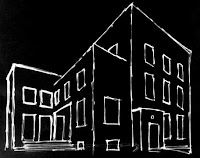Reading
a fascinating text at the moment called Mysticism
and Architecture – Wittgenstein and the Meanings of the Palais
Gainsborough by
Roger Paden. A philosophical piece, Paden attempts to connect
Wittgenstein’s philosophy to the Palais Stonborough, a “modernist”
building mostly designed and built by Ludwig Wittgenstein for his
sister during fin- de- siecle Vienna.
Ludwig
Wittgenstein is known as one of the most controversial and popular
philosophers of the twentieth century. He became famous throughout
Europe after publishing the infamous, Tractatus
Logico-Philosophicus,
a difficult text dealing with the logical structure of propositions
and the nature of logical inference, developing succinct arguments on
Epistemology, Principles of Physics, Ethics and the “Mystical”.
I’ve read this text several times and also various interpretations
of the work from noteworthy philosophers but continue to find it
troubling. Having only a background in continental philosophy,
Logical Positivism is a hard reach for me, particularly having only a
first year undergraduate knowledge of logic.
Nevertheless,
Wittgenstein evolved his philosophy after WW1, lecturing at Cambridge
University until his death in 1951. Wittgenstein’s last work,
published posthumously, so named Philosophical
Investigations
to be sure, once one understands his foundational arguments, is a
much more accessible work, and well worth the time exploring.
Before
WW1, Wittgenstein studied engineering in Britain, however through his
reading found the works of Russell and Frege to be fascinating, to
then go to Cambridge to talk with Russell and ask if he was “suited”
to study philosophy. Russell found the young man extremely
intelligent, and well versed in mathematics and logic. Wittgenstein
attended lectures at the university for almost two years, listening
to luminaries such as Moore and Russell, to then attempt to re-think
the direction these philosophers were headed. It should be noted that
anyone at that time who had met the young Austrian, found his
conversation and presence overwhelming yet compellingly
brilliant.
WW1
began and changed the minds, attitudes and perceptions of
Europe.
Wittgenstein
came from one of the wealthiest families in the Austrian Hungarian
Empire. Father Karl Wittgenstein made his fortune in manufacturing,
steal, ore and financing, only to retire at an early age becoming a
patron of the arts, supporting and developing gifted artists: famous
artists, writers and composers such as Johannes Brahms, Gustav
Mahler, Pablo Casals and Gustav Klimt. Margaret, one of Ludwig’s
older sisters, and whom he designed and built Palias Stonborough, was
a patient of Sigmund Freud for years, eventually responsible for
getting the doctor out of Vienna during the Nazi occupation. Young
Ludwig was raised in this environment. His brother Paul Wittgenstein,
a well known pianist, lost his arm during WW1, only to have Maurice
Ravel compose “Concerto for the Left Hand” for him, because after
the war, taught himself to play the piano with only his left hand.
(If you have not heard a recording of one of Paul Wittgenstein’s
performances, it is actually quite astounding.)
Rich,
smart and definitely full of himself, young Wittgenstein returned to
Austria from England and joined to battle against the German enemy
which included his English teachers and friends (An irony he was all
too aware of.)
Somewhat
difficult to understand, at the turn of the last (19th to 20th)
century, war was seen as something heroic and romantic. Well, to say
the least, after millions of innocent lives lost for the elite goal
of power between the German, French and English aristocracies,
absolutely no one would see war in the same positive light. The
“Spirit of the Age” shifted and those that did battle, those that
suffered and survived, viewed the world in a different way… so too
Herr Wittgenstein.
After
receiving commendations for bravery, etc, spending a year in an
Italian prisoner of war camp, finishing the “Tractatus”, returned
to Vienna a much different man.
During
the Great War, Karl Wittgenstein died, leaving a huge inheritance for
Ludwig… (In today’s money: many millions) but he gave most of it
away to charities, friends and back to his sisters, he kept none of
the money).
Wittgenstein,
although Jewish but raised a strict Catholic, right after the war,
attempted to join a catholic monastery…the monks found his reasons
and his destiny not suited for their life, however hired him as a
gardener for two years. Wittgenstein then decided that serving people
was necessary thus attended teacher’s school for two years to
become the only primary teacher in a small town outside of Vienna. He
taught well but was accused of treating some student’s too harshly
and resigned after five years of teaching to then return to
Vienna.
It
was during this time that he helped design and build Palais
Stonborough.
Hermine
and Margaret loved their little brother beyond measure, considering
the two older brothers, under the hammer from “dad” to follow in
the family business, both committed suicide.
Margaret
was pleased to see her brother. Changed from the war, yes, though she
could still see that light in his eyes…a project!
One
can only imagine after their two older brothers reported dead from
suicide, Hermine and Margaret, seeing their two younger brothers,
Ludwig and Paul for the first time would have been
emotional.
Margaret
has piles of inheritance- cash and wants to build a house or a
‘salon’ to establish a place or haven to house the artists,
writers, and musicians of the world…like her father…
Ludwig
arrives from the monastery…finally home from the war.
One
can only imagine her delight, to see her little brother home after so
many years.
While
a prisoner of war in Italy, Wittgenstein met a fellow intellectual,
Paul Engelmann, an architect, a religious man to whom Wittgenstein
could relate.
Like
a good sister would, Margaret connected them after the war, where
Engelmann was in the midst of designing her “salon”.
Surprisingly
not, Margaret observed her brother dive into the design and building
of the project with alacrity, as was his style and
sensibility.
According
to Paden, the home’s design and building is Wittgenstein’s
sensibility from the door hinges to the window frames. In the end,
the entire project was the philosophers creation down to every minute
detail.
Why
I chose to read this text is the theses of connecting a philosopher’s
work to a moment in time of his past, and his creation of a beautiful
building, how has this author managed to connect the two?
So
far so good...
Paden
understands architecture and philosophy…and Wittgenstein as well,
but we shall see.
















